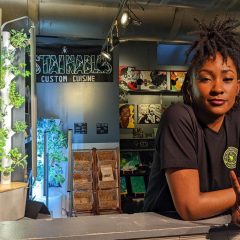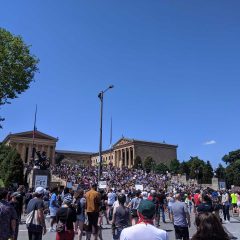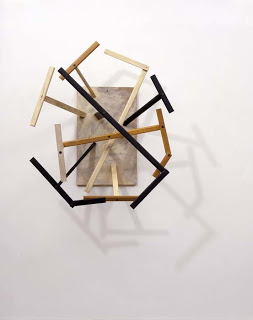
On a trip to NYC last week two exhibitions made the day worthwhile. Al Taylor studied painting at the Kansas City Art Institute and worked in New York from 1970 until his death in 1999, but his most important exhibitions have been in Europe (Bern 1992, Luzern 1999 and Munich 2006). I admit I didn’t know Taylor’s work before December, when I saw it in two galleries at Art Basel Miami Beach. Zwirner and Wirth is exhibiting his early work through March 1, and the unassuming drawings and wooden, wire and string constructions which the artist called drawings in space make a major statement, despite their modesty. The work, done between 1985-89, shows an artist using the simplest possible materials to explore forms and movement in space.

Al Taylor Untitled (Bra) (1987) wooden broomsticks with enamel paint, wood, acrylic and laytex paint mounted on formica laminate, 54 x 41 x 32 ½ in., photo courtesy of Zwirner and Wirth, © Estate of Al Taylor
Taylor’s use of pencil, ink and watercolor for drawings and painted wood, broomsticks, string and wire for the wall-mounted and occasional floor constructions is always functional; he was uninterested either in craftsmanship for its own sake or in poor materials as a statement. The forms often imply a range of motion, as if they might rotate in space, unfold or collapse into themselves. The five wooden discs of 6-8-9 (1988, brass, wood and enamel paint mounted on wood) are in the momentary equilibrium of a juggler; Untitled (Latin Study) suggests a machine that generates energy through its clock-wise rotation, and Untitled (Bra) resembles an isometric rendering of an up-turned wooden table about to be rotated.

Al Talyor No Title (1986) pencil, watercolor, ink washes and correction fluid on paper torn from spiral ring sketchbook, 12 x 9 in., photo courtesy of Zwirner and Wirth, © Estate of Al Taylor
The exhibition includes a number of drawings for the three-dimensional pieces on view and others, unrealized but equally suggestive. They present an intimate view of an artist of great integrity and vision who took his work but not himself too seriously, and could conjure strength from almost evanescent materials.
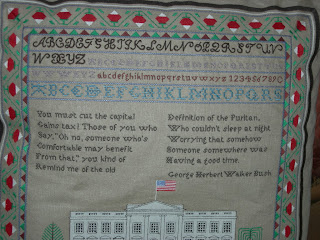
Hans Haacke Trickle Up (installation detail), 1992, embroidered pillow, photo Andrea Kirsh, © Hans Haacke
Paula Cooper Gallery is exhibiting just five works by Hans Haacke through Feb. 16, but they form a remarkable overview of this major artist’s career. Photographic Notes, perhaps Haacke’s earliest piece, was unknown to me and I know Haacke’s work well. I installed his survey, Hans Haacke; Unfinished Business (organized by the New Museum) at the Lowe Art Museum in 1987; it is still the only large, survey exhibition of Haacke’s work held in the U.S.. Photographic Notes consists of 26 photographs taken at Documenta II (1959) and reveals Haacke’s early interest in the circumstances of exhibition and the interaction of art and audience; his photo of a woman playing with an infant in front of a large Pollock inevitably recalls Pollock’s work used as a back drop for a Cecil Beaton photo-shoot in Vogue, in 1951.
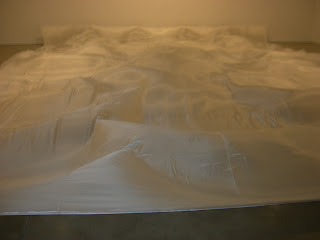
Hans Haacke Wide White Flow (1967) white fabric and fans, 32 ½ x 38 feet, installed at Paula Cooper Gallery, 2008, photo Andrea Kirsh, © Hans Haacke
Wide White Flow (1967), an entire room filed with a huge, fluttering piece of white satin activated by large fans is one of a number of works in which Haacke explored natural systems such as wind, electricity and water cycles. The poetic, visual beauty of the piece, which resembles a foamy ocean surf, anticipates the visual elegance that underpins Haacke’s later and more overtly-political work.
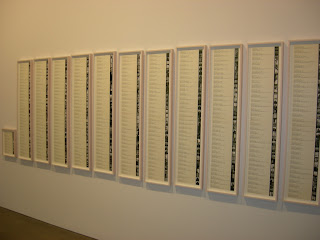
Sol Goldman and Alex DiLorenzo Manhattan Real Estate Holdings; a Real-Time Social System, as of May 1, 1979 (1971) at Paula Cooper Gallery, 2008, map in six sections (20 x 24 in. each), 24 type-written sheets with photographs (23 x 9 in. each), one 17 x 9 in. and one 21 1/4 x 9 in., one typewritten sheet photoenlargement 24 x 20 in., photo Andrea Kirsh, © Hans Haacke
Sol Goldman and Alex DiLorenzo Manhattan Real Estate Holdings; a Real-Time Social System, as of May 1, 1971 is one of the pieces in which Haacke, having moved from natural to social systems, investigated the real estate holdings of major New York slum-lords. Plans to exhibit three of these works provoked the cancellation of Haacke’s exhibition at the Guggenheim Museum in 1971, six weeks before its scheduled opening (the best-known piece was Shapolsky et al, Manhattan Real Estate Holdings; a Real-Time Social System, as of May 1, 1971).
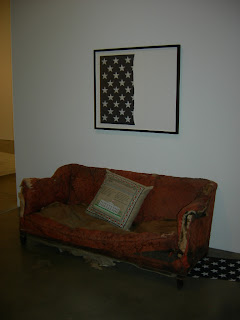
Trickle Up (1992) and Mission Accomplished (2005) installed at Paula Cooper Gallery, 2008, photo Andrea Kirsh, © Hans Haacke
Finally, two more recent works were installed as an installation: Trickle Up (1992) and Mission Accomplished (2005). Together they form Haacke’s tribute to the Bush family’s contribution to democracy in America. On a battered couch, suggestive of the actual living conditions of many working-class Americans, a pillow with cross-stitched commentary heralds George H.W. Bush’s use of nostalgic patriotism to mask his reverse-Robin Hood economic policies; the torn U.S. flag, a fragment framed above the couch, another fragment on the floor is in homage to George W. Bush’s shredding of American political values in the name of flag-waving, militaristic patriotism. Anger often drives Hans Haacke’s work, but with the best of it he keeps it in check. The bitterness and rage behind this installation is potently harnessed.




